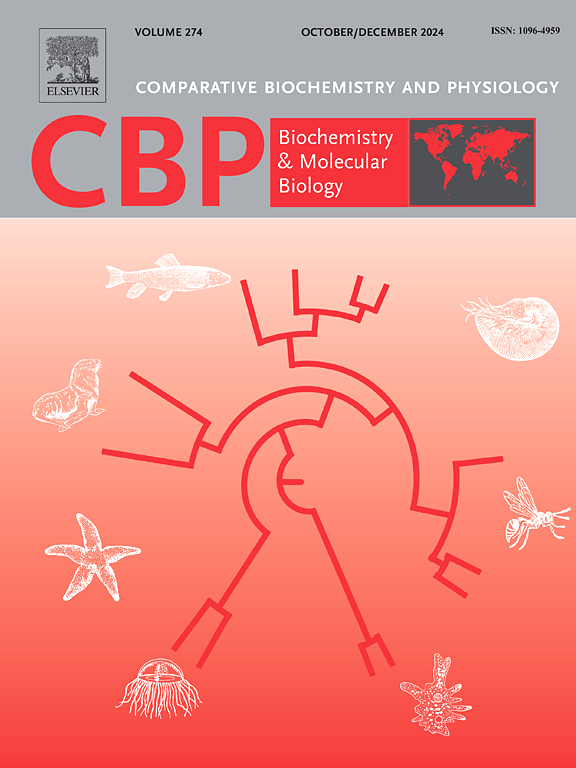Dietary short-chain fatty acid supplementation does not affect growth performance, metabolism, and oxidative status of European seabass (Dicentrarchus labrax) juveniles
IF 1.9
3区 生物学
Q4 BIOCHEMISTRY & MOLECULAR BIOLOGY
Comparative Biochemistry and Physiology B-Biochemistry & Molecular Biology
Pub Date : 2025-03-27
DOI:10.1016/j.cbpb.2025.111096
引用次数: 0
Abstract
This study investigated the effects of dietary short-chain fatty acid (SCFA) supplementation, on growth performance, metabolism, and antioxidant status of European seabass juveniles. Six isoproteic (43 % crude protein) and isolipidic (18 % crude lipid) diets were formulated to include 0.25 and 0.50 % Sodium acetate (SA), Sodium propionate (SP), or Sodium butyrate (SB). A diet without SCFA supplementation was used as a control. The diets were fed to triplicate groups of European seabass juveniles (initial body weight of 15 g) for 56 days. The supplementation of SCFA in the diet had no impact on the growth, feed utilization, or body composition of seabass. In the intestine, gene expression of pyruvate kinase (pk) and glucokinase (gk), phosphoenolpyruvate carboxykinase (pepck), glucose facilitative carrier type 2 (glut2), and citrate synthase (cs) was lower in fish fed the SP0.50 diet than in the other groups. Moreover, fatty acid synthase (fas) gene expression was lower in fish fed the SA0.25, SA0.50, and SB0.25 diets than in the other groups. Further, catalase (CAT) and glutathione reductase (GR) activity and lipid peroxidation (LPO) levels showed no differences between groups. In contrast, glutathione peroxidase (GPX) activity was higher in fish fed the SP0.50 diet. In the liver, GR activity and LPO levels showed no differences between groups. In contrast, CAT activity was lower in all dietary treatments than in control, and GPX and G6PDH activity was lower in fish fed with the SB (0.25 and 0.50 %) diet than in the other diets. Overall, SCFA supplementation did not affect growth performance and feed utilization and only had minor effects on metabolism and antioxidant defense mechanisms.

饲料中添加短链脂肪酸不影响欧洲鲈鱼幼鱼的生长性能、代谢和氧化状态。
本试验研究了饲料中添加短链脂肪酸(SCFA)对欧洲鲈鱼幼鱼生长性能、代谢和抗氧化状态的影响。配制6种异蛋白(43 %粗蛋白质)和等脂(18 %粗脂肪)饲粮,分别为0.25和0.50 %醋酸钠(SA)、丙酸钠(SP)和丁酸钠(SB)。不添加短链脂肪酸的日粮作为对照。将饲料投喂初始体重为15 g的三组欧洲鲈鱼幼鱼,投喂56 d。饲料中添加短链脂肪酸对鲈鱼的生长、饲料利用率和体组成均无影响。在肠道中,SP0.50饲料中丙酮酸激酶(pk)和葡萄糖激酶(gk)、磷酸烯醇丙酮酸羧激酶(pepck)、葡萄糖促进载体2型(glut2)和柠檬酸合成酶(cs)的基因表达量低于其他各组。此外,SA0.25、SA0.50和SB0.25组的脂肪酸合成酶(fas)基因表达量低于其他各组。过氧化氢酶(CAT)和谷胱甘肽还原酶(GR)活性及脂质过氧化(LPO)水平各组间无显著差异。相比之下,SP0.50饲料的谷胱甘肽过氧化物酶(GPX)活性较高。肝脏中GR活性和LPO水平各组间无显著差异。与此相反,各饲料处理的CAT活性均低于对照组,添加SB(0.25和0.50 %)饲料的GPX和G6PDH活性均低于其他饲料。总体而言,添加短链脂肪酸不会影响生长性能和饲料利用率,仅对代谢和抗氧化防御机制有轻微影响。
本文章由计算机程序翻译,如有差异,请以英文原文为准。
求助全文
约1分钟内获得全文
求助全文
来源期刊
CiteScore
4.60
自引率
4.50%
发文量
77
审稿时长
22 days
期刊介绍:
Comparative Biochemistry & Physiology (CBP) publishes papers in comparative, environmental and evolutionary physiology.
Part B: Biochemical and Molecular Biology (CBPB), focuses on biochemical physiology, primarily bioenergetics/energy metabolism, cell biology, cellular stress responses, enzymology, intermediary metabolism, macromolecular structure and function, gene regulation, evolutionary genetics. Most studies focus on biochemical or molecular analyses that have clear ramifications for physiological processes.

 求助内容:
求助内容: 应助结果提醒方式:
应助结果提醒方式:


